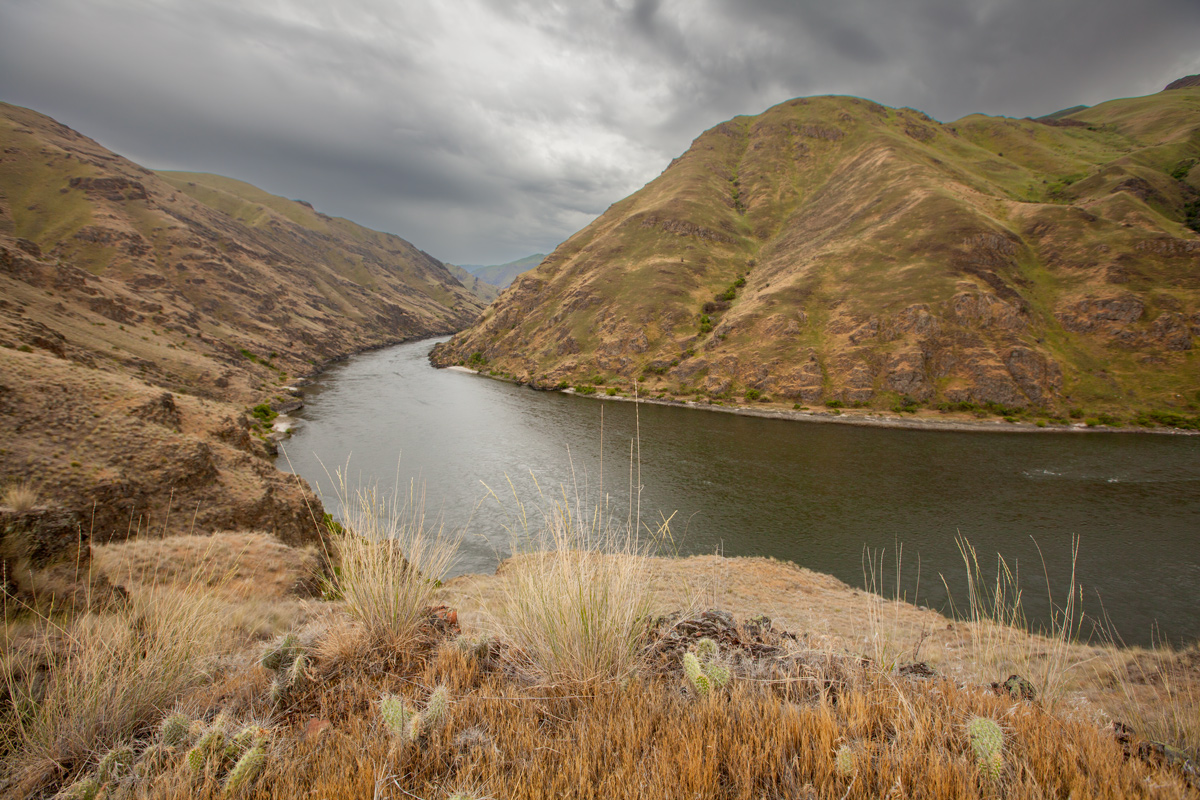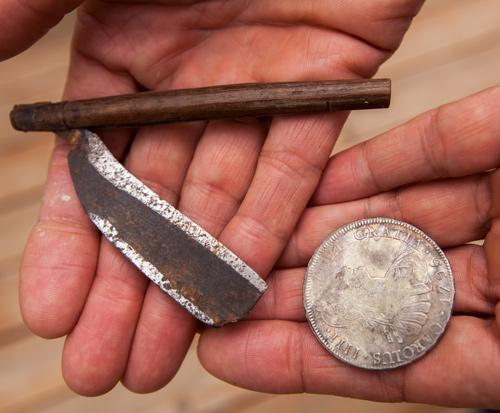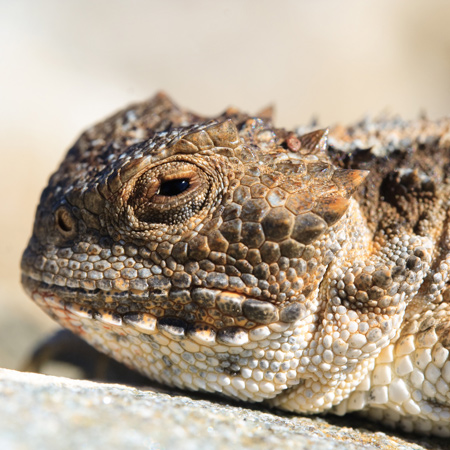Sgt. John Ordway‘s group climbs up from the Salmon River and then descends to the Snake River where there is a Nez Perce village of salmon fishers. There, Pvt. Robert Frazer trades his old razor for two Spanish dollars. At Long Camp, Lewis describes the short-horned lizard (Phrynosoma hernandesi) and prepares four plant specimens—all new to science.
Still Waiting
by Yellowstone Public Radio[1]Originally aired weekdays by Yellowstone Public Radio during the Bicentennial observance of 2003-2006. Narrated by Hal Hansen. Scripts by Whit Hansen and Ed Jacobson. Produced by Leni Holliman. © … Continue reading
Snake River Hills
© 26 May 2013 by Kristopher K. Townsend. Permission to use granted under the Creative Commons Attribution-Share Alike 4.0 International license.
Above: Looking upriver from the Nez Perce village visited by Ordway on this day.
Snake River Fishery
Worst Hills Ever
bore to the right up a creek. passd one lodge crossed a steep bad hill and descended down a long hill an a run pass a large lodge and descended the worst hills we ever saw a road made down.
—John Ordway
Finding the Salmon
our chief told us to set down and not go in the lodge untill we were invited so we did at length they invited us in. spread robes for us to sit on and Set a roasted Salmon before us and Some of their white bread which they call uppah. we eat hearty of this fat fish but did not eat ¼ of it.
—John Ordway
Razor and Spanish Mill Dollar
Historical interpretation by John W. Fisher. Photo © 2013 by Kristopher K. Townsend. Permission to use granted under the Creative Commons Attribution-Share Alike 4.0 International license.
One Razor for Two Dollars
Frazer got 2 Spanish mill dollars from a squaw for an old razer we expect they got them from the Snake [Lemhi Shoshones] Indians who live near the Spanish country to the South.
—John Ordway
Long Camp
Slow Day
No movement of the party today worthy of notice. we have once more a good stock of meat and roots. Bratton is recovering his strength very fast; the Child [Jean Baptiste Charbonneau] and the Indian Cheif are also on the recovery. the cheif has much more uce of his hands and arms.
—Meriwether Lewis
Short-horned Lizard
a speceis of Lizzard called by the French engages [engagés] prarie buffaloe are native of these plains as well as of those of the Missouri. I have called them the horned Lizzard. they are about the size and a good deel the figure of the common black lizzard. but their bellies are broader, the tail shorter and their action much slower; they crawl much like the toad.
—Meriwether Lewis
Four Plant Specimens
Cascara Buckthorn
About 12 feet high, in Clumps. Fruit a 5-valved purple berry which the natives eat &esteen highly; the berry depressed globous. On the waters of the Kooskooskee [Clearwater] May 29th 1806.
—Meriwether Lewis[2]Frangula purshiana. Moulton, ed. Herbarium, specimen 69a.
Cascara buckthorn, Frangula purshiana
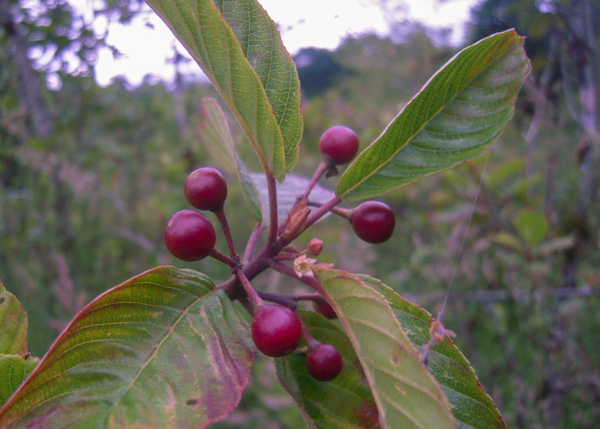
© 25 June 2012 by Jesse Taylor. Permission granted under the Creative Commons Attribution-Share Alike 3.0 Unported license.
This plant’s name honors Frederick Pursh.
Creambush Oceanspray
A Shrub growing much in the manner of Nine bark On the waters of Kooskooskee May 29th 1806.
—Meriwether Lewis[3]Holodiscus discolor. Moulton, ed. Herbarium, specimen 78a.
Creambush oceanspray, Holodiscus discolor
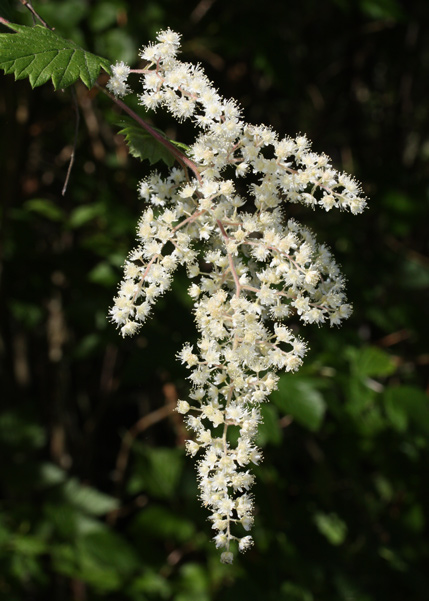
© 4 July 2009 by Walter Siegmund. Permission to use granted under the Creative Commons Attribution-ShareAlike 3.0 Unported license.
Bitter Cherry
Prunus A Smaller Shrub than the Choak cherry, the natives count it a good fruit. On the Kooskooskee May 29th 1806
—Meriwether Lewis[4]Prunus emarginata. Moulton, ed. Herbarium, specimen 140.
Bitter Cherry, Prunus emarginata
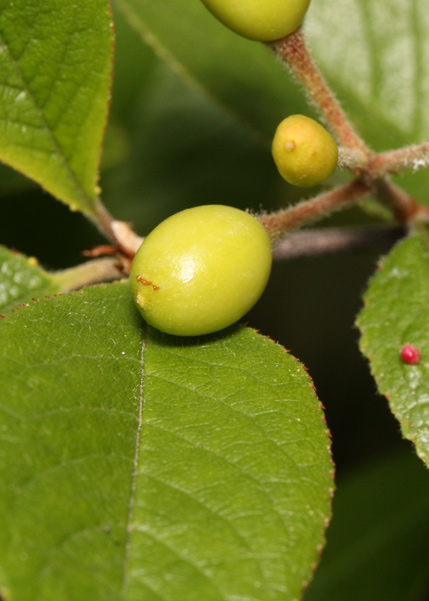
© 26 June 2009 by Walter Siegmund. Permission under the Creative Commons Attribution-Share Alike 3.0 Unported license.
Black Chokecherry
Prunus Choak or Pidgeon Cherry On the waters of Kooskoosky May 29th 1806.
—Meriwether Lewis[5]Prunus virginiana. Moulton, ed. Herbarium, specimen 141a.
Black Chokecherry, Prunus virginiana var. melanocarpa
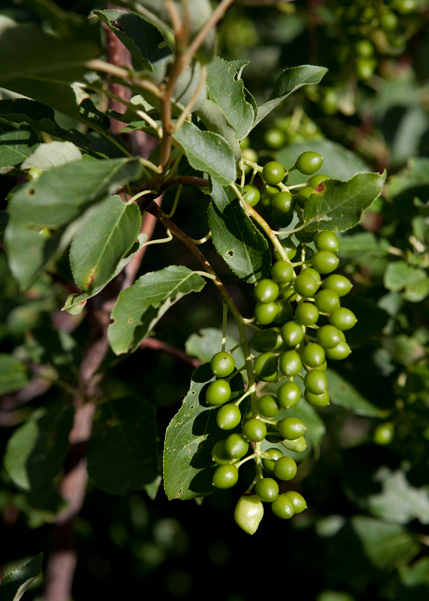
Location: Sun River near Simms, Montana. © 20 July 2011 by Kristopher K. Townsend. Permission to use granted under the Creative Commons Attribution-Share Alike 4.0 International license.
Weather Diary
State of the Weather at rise
Wind at rise
State of the Weather at 4 P.M. Wind at 4 P.M. State of the Kooskooskee cloudy after rain & thunder S E cloudy after rain N W raised 1 ft. 5 in. frequent and heavy showers attended by distant thunder through the night. the river raised 6 inches in the course of yesterday and 1 foot 5 I. in the course of the last night. it is now as high as there are any marks of it’s having been in the spring 1805.— at 10 A. M. it arrived at it’s greatest hight having raised 1½ inches from sunrise to that time. in the ballance of the day it fell 7 inches. the natives inform us that it will take one more rise before it begins finally to subside for the season and then the passage of the mountains will be practicable.—
—Meriwether Lewis[6]To assist the reader of this web page, the date column is not presented, the river columns have been merged, and some abbreviations have been spelled out.
Experience the Lewis and Clark Trail
The Lewis and Clark Trail Experience—our sister site at lewisandclark.travel—connects the world to people and places on the Lewis and Clark Trail.
Plan a trip related to May 29, 1806:

Notes
| ↑1 | Originally aired weekdays by Yellowstone Public Radio during the Bicentennial observance of 2003-2006. Narrated by Hal Hansen. Scripts by Whit Hansen and Ed Jacobson. Produced by Leni Holliman. © 2003 by Yellowstone Public Radio. |
|---|---|
| ↑2 | Frangula purshiana. Moulton, ed. Herbarium, specimen 69a. |
| ↑3 | Holodiscus discolor. Moulton, ed. Herbarium, specimen 78a. |
| ↑4 | Prunus emarginata. Moulton, ed. Herbarium, specimen 140. |
| ↑5 | Prunus virginiana. Moulton, ed. Herbarium, specimen 141a. |
| ↑6 | To assist the reader of this web page, the date column is not presented, the river columns have been merged, and some abbreviations have been spelled out. |
